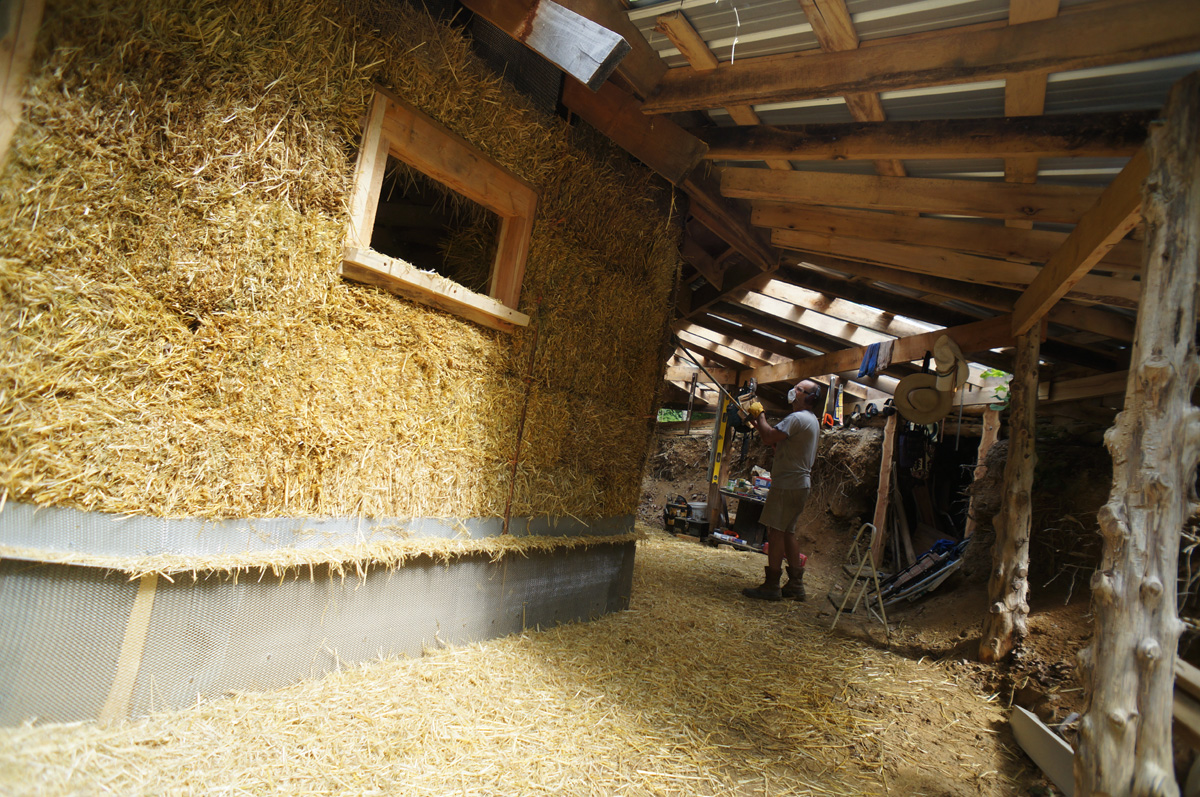If you’re new to natural building, two of the most important fundamental concepts to understand are thermal mass and insulation. Materials for constructing walls typically fall into one category or the other. Understanding the differences will be critical if your goal is to build an efficient, comfortable house appropriate for your local climate. Let’s look at thermal mass and insulation in the simplest terms possible.
What is Thermal Mass?
A succinct definition of thermal mass can be found on wikipedia: “In building design, thermal mass is a property of the mass of a building which enables it to store heat, providing ‘inertia’ against temperature fluctuations.” Think of thermal mass like a storage battery — a massive wall is very good for storing thermal energy, and it’s always working to achieve thermal equilibrium. Have you ever walked barefoot on hot pavement in the summer long after the sun has set? That’s the pavement’s ability to absorb, store, and release thermal energy at work.
Massive walls (stone, cob, rammed earth, etc.) work exactly the same way. When exposed to the sun and warm air temperatures, the walls will store heat energy and later release that energy. Similarly, when the air temperature is cold, a massive wall will eventually conform to the ambient air temperature and have a hard time budging from that state, especially if the sun is absent for long stretches of time.
Massive walls are by definition NOT insulating. Cob does not have insulation. Rammed earth walls do not have insulation. Stone does not have insulation. If someone tells you otherwise, stop right there. There is no R-value associated with these materials. Also, do you see an obvious similarities between these different building materials? They are solid, heavy, and there is no air space contained within them.
Generally speaking, building the exterior walls of your home with massive materials is best reserved for very mild or desert climates. In other words, massive walls are inappropriate for cold climates, where air temperatures frequently dip below freezing and do not rise for days at a time.
Massive walls particularly excel in desert climates, where the daytime temperatures are high, and the nighttime temperatures are cool or cold. (This is referred to as diurnal temperature variation, or significant variation in daily temperature from daytime to nighttime.) In this setting, a massive wall will absorb thermal energy during the heat of the day, and once the air temperatures have dropped at night, the wall will slowly release this stored energy into the living space.
What is Insulation?
Insulation provides the ability to reduce heat transfer from one side of a wall to another. Insulating materials are the opposite of massive materials — they’re lightweight and have dead air space contained within them, and they serve as a buffer to heat and cold. (Important to note here is that it’s not the actual straw in a straw bale, or the fiberglass in a fiberglass batting that is insulating — it’s the air space contained with those and other insulative materials.)
Here’s an important aspect of understanding insulation, summarized neatly by energy.gov: “An insulating material’s resistance to conductive heat flow is measured or rated in terms of its thermal resistance or R-value — the higher the R-value, the greater the insulating effectiveness. The R-value depends on the type of insulation, its thickness, and its density.” (I recommend reading the full article on insulation on energy.gov here.)
All insulating materials are not made equal, yet the end goal is the same. Some are more effective at reducing heat transfer than others. Straw bale is regularly quoted at about R-2.5 per inch. Light clay straw is lower, at about R-1.5 per inch (largely due to the clay present in the wall and the density of the material.) Natural materials with high R-values are difficult to come by. Synthetic materials (including foam board) frequently have higher R-values per inch, up to R-6.5 per inch.
In the most simplistic terms: the higher the R-value, the more effective the insulation is. The more effective the insulation is, the less thickness you need to achieve high levels of efficiency. There’s more to it than this, of course, but this is the primary point of understanding.
The Marriage Between Thermal Mass and Insulation
A successful, efficient natural home design usually incorporates some combination of both thermal mass and insulation. (Again, this is a generalization, but large swaths of the US benefit from homes built with insulative exterior walls.) For example, in a cold climate setting, straw bale walls will provide an excellent buffer to both heat and cold. A thick clay plaster finish over the straw bales will add thermal mass, which helps maintain thermal equilibrium inside the living space.
Clay plaster can serve as a battery for storing heat generated by a wood stove in the winter, making the heat available for a longer period of time. A massive floor system, such as an earthen floor with radiant heat is a great way to capture, store, and slowly release heat energy.
The most efficient home designs incorporate the strengths of highly insulated roofs and walls, and massive elements for heat storage and temperature moderation. How you plan and balance those elements will depend on the specifics of your exact site.
Ultimately, your local climate should dictate your choice of building materials. If planning a new build, ask yourself: “what appropriate materials can I use to build an efficient, comfortable, and healthy house for my specific local climate?”






I wouldn’t call a desert climate a mild climate – but for the rest I totally agree with you 😉
Thanks for commenting. I agree, and edited for clarification!